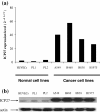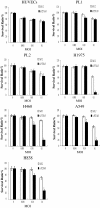MicroRNA-145 regulates oncolytic herpes simplex virus-1 for selective killing of human non-small cell lung cancer cells
- PMID: 23876001
- PMCID: PMC3734208
- DOI: 10.1186/1743-422X-10-241
MicroRNA-145 regulates oncolytic herpes simplex virus-1 for selective killing of human non-small cell lung cancer cells
Abstract
Background: Non-small cell lung cancer (NSCLC) is the leading cause of cancer-related mortality worldwide, and novel treatment modalities to improve the prognosis of patients with advanced disease are highly desirable. Oncolytic virotherapy is a promising approach for the treatment of advanced NSCLC. MicroRNAs (miRNAs) may be a factor in the regulation of tumor-specific viral replication. The purpose of this study was to investigate whether miRNA-145 regulated oncolytic herpes simplex virus-1 (HSV-1) can selectively kill NSCLC cells with reduced collateral damage to normal cells.
Methods: We incorporated 4 copies of miRNA-145 target sequences into the 3'-untranslated region of an HSV-1 essential viral gene, ICP27, to create AP27i145 amplicon viruses and tested their target specificity and toxicity on normal cells and lung cancer cells in vitro.
Results: miRNA-145 expression in normal cells was higher than that in NSCLC cells. AP27i145 replication was inversely correlated with the expression of miRNA-145 in infected cells. This oncolytic HSV-1 selectively reduced cell proliferation and prevented the colony formation of NSCLC cells. The combination of radiotherapy and AP27i145 infection was significantly more potent in killing cancer cells than each therapy alone.
Conclusions: miRNA-145-regulated oncolytic HSV-1 is a promising agent for the treatment of NSCLC.
Figures






References
Publication types
MeSH terms
Substances
LinkOut - more resources
Full Text Sources
Other Literature Sources

